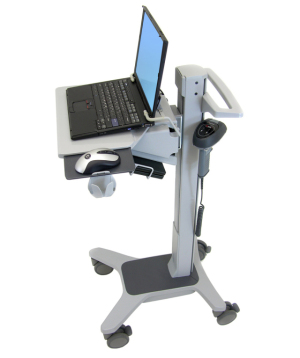by
Joan Trombetti, Writer | December 01, 2009

Neo-Flex mobile workspace
This report originally appeared in the November 2009 issue of DOTmed Business News
There has been a growing interest in ergonomic solutions in the medical field over the past few years with some recent innovations on the horizon which could change the way health care practitioners carry out their responsibilities. Ideal ergonomic design caters to patient and provider, offering comfort and safety to each.




Ad Statistics
Times Displayed: 45316
Times Visited: 1411 Keep biomedical devices ready to go, so care teams can be ready to care for patients. GE HealthCare’s ReadySee™ helps overcome frustrations due to lack of network and device visibility, manual troubleshooting, and downtime.
Many health care professionals may experience back pain, carpal tunnel, headaches and other ailments during the course of their careers. Often, the cause can be traced to poorly designed equipment which causes stress on the body.
However, when ergonomic options are introduced, it may mitigate those factors. By doing so, it has the ability to improve the quality of care given as doctors are able to concentrate more on their patient rather than a discomfort they might otherwise experience.
People typically don't perform well when they're in pain or fatigued; likewise, they don't perform well when there are design barriers to quality and productivity. Ergonomic applications are used to improve human performance through product and process design and engineering.
So why is there resistance on the part of the medical field to adopting some of these innovative ergonomic technologies? "Practitioners tend to be very skeptical about new solutions, until they are convinced that the measures will not restrict how they work," says Eric W. Golden, president and CEO of Equipois Inc., Los Angeles, Ca. In other words, practitioners must be convinced that ergonomic alterations will not only improve safety and comfort, but will not be a detriment to the efficiency they've developed.
However, some experts assert that there's more to ergonomics than just comfort or safety during primary use. "A robust human-centered design approach would focus on usability in all of the expected human interfaces through the entire design life, from manufacturing to disposal or reclamation," says Peter Budnick, Ph.D., CPE, president and CEO of Ergoweb and founder of Ergobuyer.
The FDA shares Budnick's thoughts, but that doesn't mean it's all smooth sailing.
"Although the FDA has been pushing ergonomics/human factors, the approval process for medical devices also creates some barriers to the ultimate success of these designs," says Dr. Budnick. The new product development and approval process is so time-consuming and expensive, human centered design advancements sometimes take a backseat to other functional requirements. Further, once a product has received approval, even small changes to improve ergonomics for patients and caregivers may be avoided so as not to force a new FDA approval process for the changes.

